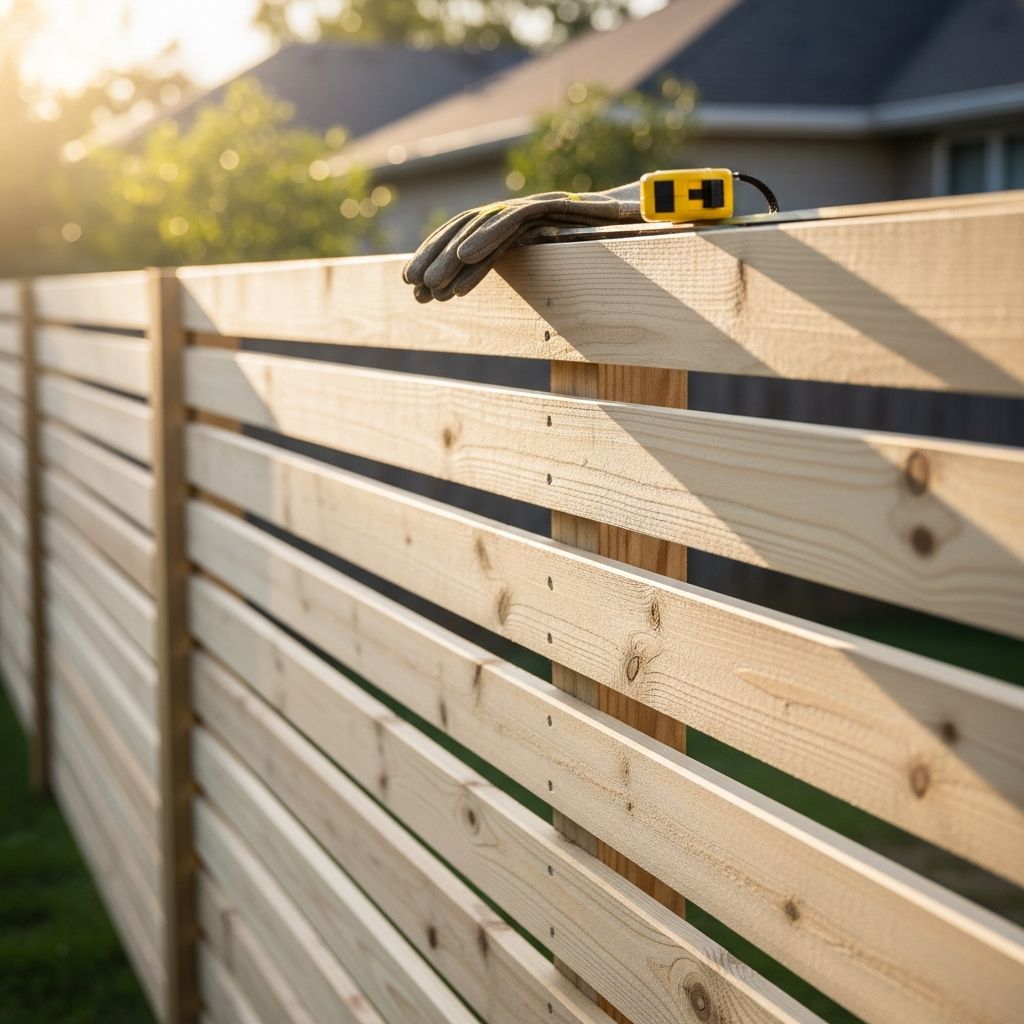How to Build an Inexpensive Slat Wood Privacy Fence
Transform your outdoor space with a modern, budget-friendly slat wood privacy fence using this comprehensive DIY guide.

Are you seeking a modern solution to privacy and curb appeal that won’t break the bank? A slat wood privacy fence is a stylish, cost-effective way to upgrade your outdoor space, offering both security and design punch. This comprehensive guide walks you through every step, from planning and purchasing materials to assembly and finishing touches. Suitable for beginners and seasoned DIYers alike, this project delivers big results with minimal expense.
Why Choose a Slat Wood Privacy Fence?
Slat wood fences, typically featuring horizontal wooden battens with uniform gaps, have soared in popularity for several reasons:
- Modern aesthetics: Clean lines and minimalist style complement a range of home exteriors.
- Customizable privacy: Adjust slat width and gaps to strike the perfect balance between openness and seclusion.
- Cost-effective: Often cheaper than traditional solid fences, especially when using affordable wood.
- Easy to build: With the right tools and planning, even novice DIYers can achieve professional-looking results.
- Adaptable: Effective for full boundary enclosures, screens around patios, or accenting garden features.
Planning Your Slat Wood Privacy Fence
Thoughtful planning helps ensure your fence is sturdy, long-lasting, and perfectly suited to your needs.
Check Local Regulations
Before you begin, research any local guidelines, HOA rules, and city permits that may apply to your property. Some communities limit fence heights or require formal approval for new structures.
Design Considerations
- Height: Standard privacy fences typically range from 5 to 6 feet. For low screens or decorative boundaries, 3 to 4 feet may suffice.
- Batten size: Wide boards (e.g., 1×4 or 1×6) offer more privacy, while narrow strips introduce greater airflow and visual lightness.
- Gap spacing: A typical gap is 1/4″ to 1/2″. Spacers ensure precise, uniform results.
- Posts: Plan for strong end, corner, and in-line posts. Standard post spacing is 6 to 8 feet for best stability.
- Finish: Consider whether you’ll oil, stain, paint, or leave the wood natural.
Measuring and Sketching
- Use a tape measure and marking paint or stakes to lay out your fence line.
- Create a simple to-scale sketch showing post locations, slat layouts, and gates (if any).
- Note ground slopes and obstructions—slats may need to be stepped or racked to accommodate uneven terrain.
Materials and Tools List
Having the right materials and tools on hand makes the process faster and less frustrating.
Materials
- Pressure-treated fence posts (4×4 recommended for most projects)
- Treated wood battens or slats (ideally 1×4 or 1×6 boards, or roofing battens for a slim look)
- Concrete or rapid-set post mix
- Galvanized screws or nails (outdoor-rated)
- Decking oil, wood stain, paint, or exterior wood finish (optional for finishing)
- Weed membrane (optional, for preventing vegetation below fence line)
- Brackets or bolt-down post supports (if attaching to concrete or wall)
- Spacers (store-bought plastic tile spacers or homemade wooden strips)
Tools
- Measuring tape
- Spirit level or laser level
- Drill/driver or nail gun (with outdoor-rated fasteners)
- Saw (hand saw, circular saw, or miter saw)
- Rubber mallet
- Hammer
- Post hole digger or spade
- String line and stakes
- Pencil or chalk for marking lines
- Sandpaper
Step-by-Step: Building Your Fence
Step 1: Preparing the Area
- Clear vegetation and debris from your planned fence line.
- Stretch a taut string between two stakes to mark a perfectly straight run.
- Measure and mark the positions for all posts at regular intervals (every 6–8 feet).
Step 2: Setting Posts
The longevity and stability of your slat fence depend on well-installed posts.
- Dig post holes around 24″–30″ deep and 8″–12″ wide (deeper in loose or sandy soil).
- Add a gravel layer at the bottom for drainage.
- Set posts in holes, ensure they are plumb and aligned with both string line and level.
- Secure posts with rapid-set post mix or concrete. Brace them in position while setting.
- Allow posts to set (usually 20–30 minutes for rapid-set, longer for full concrete cure).
Step 3: Planning and Laying Out Battens
- Determine total fence height and do a dry layout on the ground, accounting for your preferred slat width and gap.
- Cut or order battens to the exact length required for each bay (distance between posts).
- Pro tip: Treat cut ends with wood preservative to guard against rot.
- For a consistent look, use plastic tile spacers or make your own from plywood or scrap timber—ensure identical gaps between each slat.
Step 4: Attaching Horizontal Rails (Optional but Recommended)
Adding horizontal rails strengthens your fence, especially for taller runs.
- Install a top and bottom rail between posts, secured with galvanized screws or nails. These rails are the foundation for your slats.
- For additional support, include a middle rail roughly halfway up the posts.
- Position the bottom rail a few inches off the ground to prevent wood decay from soil moisture.
Step 5: Installing Slats/Battens
- Begin at the bottom of each bay and work up. Double-check your first slat for levelness; each subsequent slat will follow its position.
- Secure each batten horizontally to the front of the posts or rails using two outdoor-rated screws or nails at each end.
- Position spacers between slats for even, repeatable gaps.
- Step back every few rows to assess alignment and overall straightness; small adjustments now save headaches later.
- Repeat the process until the desired height is reached.
Step 6: Finishing Options
Finish your slat wood fence to suit your style, budget, and wood choice.
- Left natural: Untreated timber weathers to a soft silver-grey patina; this look appeals to many but offers only basic protection.
- Oiled: Decking oil or exterior wood oil enhances natural grain and boosts weather resistance; reapply annually.
- Stained or painted: Exterior-grade stains and paints unlock a universe of color options and extra weatherproofing. Deep charcoals and greens are currently trending for modern homes.
- Varnished: Clear polyurethane or marine varnish creates a sealed, wipeable surface but may require more upkeep.
Tip: Allow new timber to dry out fully before applying oil, stain, or paint—in warm months, a week or two is often enough. Correct moisture balance ensures a strong bond and finish longevity.
Additional Tips and Pro Advice
- Wear protective gear when cutting or drilling wood (safety glasses, dust mask).
- Plan to install your fence during a stretch of dry weather for best results.
- Keep tools sharp and check alignment frequently.
- If you’re using existing fence posts, assess their stability and replace any that are loose or rotten.
- For fences over 6 feet, check with local authorities for required bracing or design modifications.
- For extra-long runs that end mid-board, stagger joints like brickwork for a stronger, more professional look.
Design Inspiration: Modern Options for Slat Fences
- Varied gaps: Mix up slat widths and gap sizes for a one-of-a-kind pattern.
- Combined materials: Pair slats with metal posts or frames for an ultra-modern contrast.
- Vertical slats: Flip the orientation for a distinct take that works well in tight spaces or as feature panels.
- Integrated planting: Leave narrow ledges or boxes to hold plants, climbing vines, or lighting.
Common Mistakes to Avoid
- Skipping permits: Always check legal requirements to avoid costly setbacks.
- Poor post alignment: Uneven posts create noticeable wobbles in slat runs.
- Ignoring wood treatment: Untreated ends and screws risk rot and rust.
- Inconsistent gaps: Always use spacers for a crisp, modern finish.
- Neglecting drainage: Posts that sit in water will decay quickly; always use gravel.
Frequently Asked Questions
Q: Can I build a slat wood privacy fence on my own?
A: Yes, most DIYers with basic carpentry skills and common tools can successfully build a slat wood privacy fence. The project is straightforward with proper planning and patience, but recruit an assistant for heavy lifting or long fence runs.
Q: What wood is best for a slat fence?
A: Pressure-treated pine is the most budget-friendly and readily available, while cedar and redwood offer natural durability, improved rot resistance, and beautiful aging—at higher cost. For a bold look, painted battens also work well.
Q: How do I keep my fence looking great?
A: Regularly inspect for loose fasteners, rot, or damage. Reapply oil or stain every 1–2 years, and touch up paint as needed. Trim plants growing against the fence and clear leaves that may cause moisture buildup at the base.
Q: What should I do if my yard is sloped?
A: You can “step” the sections by keeping each bay level and adjusting the height at each post, or “rack” (angle) the slats to follow the grade. Both methods work, but stepped fences are easier for first-time builders.
Q: Are slat fences secure?
A: While slat fences provide privacy and deter casual intrusion, they are not as impenetrable as a solid fence. For added security, minimize gap width, choose thick slats, and ensure strong posts and fixings.
Summary Table: Slat Fence Planning at a Glance
| Step | Key Points |
|---|---|
| Design | Choose heights, slat spacing, materials. Sketch the fence plan. |
| Measuring | Mark straight lines, post locations with accurate spacing. |
| Posts | Set deep, plumb, and aligned. Use concrete or rapid-set. |
| Slat Layout | Use spacers for even gap. Start at bottom, check level. |
| Installation | Secure with outdoor fasteners. Adjust and check alignment regularly. |
| Finish | Apply oil, stain, or paint after wood dries. Maintain annually. |
Ready to Get Started?
With careful planning and this step-by-step guide in hand, you can confidently build an inexpensive slat wood privacy fence to refresh your outdoor space, increase privacy, and add long-term value to your home—all on a budget you control.












